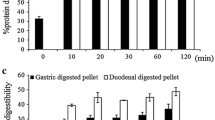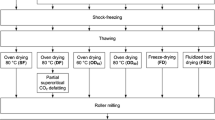Abstract
To improve the industrial use of health-functional materials based on edible insects, the objective of this study was to establish optimal conditions for improving the quality of Protaetia brevitarsis seulensis larval (PBSL) hydrolysates. PBSL was extracted using four methodologies: atmospheric pressure 50 °C-water extraction, atmospheric pressure 95 °C-water extraction, atmospheric pressure 50 °C-water enzymatic hydrolysis, and enzyme treatment under high pressure (HPE). The quality characteristics of soluble solid content, extraction yield, total protein content, protein yield, protein content with low molecular weight (LMW) (< 1kD), and the amino acid composition of hydrolysates were compared based on the different methods. All of the quality characteristics were found to be higher for HPE extracts than for the other extracts. Under optimized HPE conditions, extraction yield, protein yield, protein content with LMW, amino acid content and the content of essential amino acids increased by 3.4, 4.4 1.4 1.5, and 1.3 times respectively, compared to the other methods.


Similar content being viewed by others
References
Bobonyaratanakornkit BB, Park CB, Clark DS. Pressure effects on intra and intermolecular interactions within proteins. Biochim. Biophys. Acta. 1595: 235-249 (2002)
Bukkens SGF. The nutritional value of edible insects. Ecol. Food Nutr. 36: 287-319 (1997)
Cho RK, Hong JH. Denaturation of heat treated lysozyme under high pressure conditions. Korean J. Food Sci. Technol. 23: 366-369 (1991)
Chon JW, Kweon H, Jo YY, Yeo JH, Lee HS. Protective effects of extracts of Protaetia brevitarsis on carbon tetrachloride-induced hepatotoxicity in the mice. Korean J. Seric. Sci. 50: 93-100 (2012)
Chung MY, Gwon EY, Hwang JS, Goo TW, Yun EY. Analysis of general composition and harmful material of Protaetia brevitarsis. J. Life Sci. 23: 664-668 (2013)
Eisenmenger MJ, Reyes-De-Corcuera JI. High pressure enhancement of enzymes: A review. Enzyme Microb. Technol. 45: 331-347 (2009)
Ha YJ, Kim AY, Yoo SK. Optimization of peptide production from leg meat of Yeonsan ogae by high hydrostatic pressure and protein hydrolytic enzyme and its characteristic analysis. J. Korea Acad. Ind. Coop. Soc. 17: 182-191 (2016)
Himonides AT, Taylor AKD, Morris AJ. Enzymatic hydrolysis of fish frames using pilot plant scale systems. Food Nutr. Sci. 2: 586-593 (2011)
Jin L, Ha JH, Jeong MH, Chung EK, Chung AR, Kim JC, Ahn JH, Lee HY. Enhancement of the antioxidant and anticancer activities of Berberis koreana bark by using a low temperature and high-pressure extraction process. Korean J. Food Sci. Technol. 41: 284-291 (2009)
Kang IJ, Chung CK, Kim SJ, Nam SM, Oh SH (2001) Effects of Protaetia orientalis (Gory et Perchlon) larva on the lipid metabolism in carbon tetrachloride administered rats. Appl. Microsc. 37: 9-18
Kim CT (2009) New technology-high pressure technology for food-application and prospect as green technology. Bulletin Food Technol. 22: 321-330
Kim TE, Cho YJ, Kim CT, Cho YJ. The effect of high pressure hormesis on pterostilbene content and biological activity in blueberries. Food Eng. Prog. 19: 403-407 (2015)
Kim TE, Gil B, Kim CT, Cho YJ. Enrichment of phenolics in harvested strawberries by high-pressure treatment. Food Bioprocess Technol. 10: 222-227 (2017a)
Kim MY, Jang GY, Oh NS, Baek SY, Lee SH, Kim KM, Kim TM, Lee J, Jeong HS. Characteristics and in vitro anti-inflammatory activities of protein extracts from pre-germinated black soybean [Glycine max (L.)] treated with high hydrostatic pressure. Innov. Food Sci. Emerg. Technol. 43: 84-91 (2017b)
Kwak KW, Han MS, Nam SH, Choi JY, Lee SH, Choi YC, Park KH. Detection of insect pathogen serratia marcescens in Protaetia brevitarsis seulensis (Kolbe) from Korea. Int. J. Ind. Entomol. 28: 25-31 (2014)
Lee HJ, Bang E, Lee SY, In YW, Cho HY. Enzymatic hydrolysis of anchovy using medium-high pressure pilot plant scale systems. Food Eng. Prog. 20: 314-320 (2016)
Nam KY. The comparative understanding between red ginseng and white ginsengs, processed ginsengs (Panax ginseng CA Meyer). J. Ginseng Res. 29: 1-18 (2005)
Ohmae E, Murakami C, Gekko K, Kato C. Pressure effects on enzyme functions. J. Biol. Macromol. 7: 23-29 (2007)
Park JH, Kim SY, Kang MG, Yoon MS, Lee YI, Park EJ. Antioxidant activity and safety evaluation of juice containing Protaetia brevitarsis. J. Korean Soc. Food Sci. Nutr. 41: 41-48 (2012)
Parsons CM, Castanon F, Han Y. Protein and amino acid quality of meat and bone meal. Poultry Sci. 76: 361-368 (1997)
Pemberton RW. Insects and other arthropods used as drugs in Korean traditional medicine. J. Ethnopharmacol. 65: 207-216 (1999)
Sim SY, Ahn HY, Seo KI, Cho YS. Physicochemical properties and biological activities of Protaetia brevitarsis seulensis larvae fermented by several kinds of micro-organisms. J. Life Sci. 28: 827-834 (2018)
Slizyte R, Dauksas E, Falch E, Storro I, Rustad T. Charactieristics of protein fractions generated form hydrolysed Cod by-products. Process Biochem. 40: 2021-2033 (2005)
Surowka K, Fik M. Studies on the recovery of proteinaceous substances from chicken heads: II—Application of pepsin to the production of protein hydrolysate. J. Sci. Food Agric. 65: 289-296 (1994)
Van Hui A, Van Itterbeeck J, Klunder H, Mertens E, Halloran A, Muir G, Vantomme P. Edible insects: future prospects for food and feed security. Food and Agriculture Organization of the United Nations, Rome (2013)
Yoo YC, Shin BH, Hong JH, Lee J, Chee HY, Song KS, Lee KB. Isolation of fatty acids with anticancer activity from Protaetia brevitarsis larva. Arch. Pharm. Res. 30: 361-365 (2007)
Acknowledgements
This work was supported by the Technology Development Program (P0002762) funded by the Ministry of SMEs andStartups (MSS, Korea) and the Main Research Program (Grant number: E0187000-03) of the Korea Food ResearchInstitute (KFRI) funded by the Ministry of Science and ITC, Republic of Korea.
Author information
Authors and Affiliations
Corresponding author
Ethics declarations
Conflict of interest
The authors declare no conflicts of interest.
Additional information
Publisher's Note
Springer Nature remains neutral with regard to jurisdictional claims in published maps and institutional affiliations.
Rights and permissions
About this article
Cite this article
Kim, TE., Kim, CT., Sim, HJ. et al. Production of protein hydrolysate from Protaetia brevitarsis seulensis (Kolbe) larvae by enzyme treatment under high pressure. Food Sci Biotechnol 29, 1187–1194 (2020). https://doi.org/10.1007/s10068-020-00766-y
Received:
Revised:
Accepted:
Published:
Issue Date:
DOI: https://doi.org/10.1007/s10068-020-00766-y




